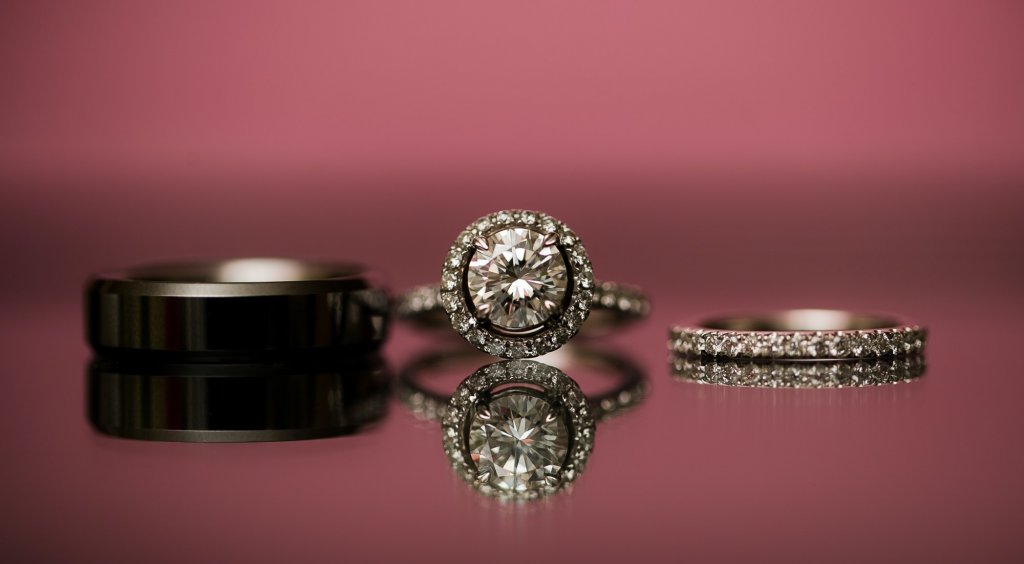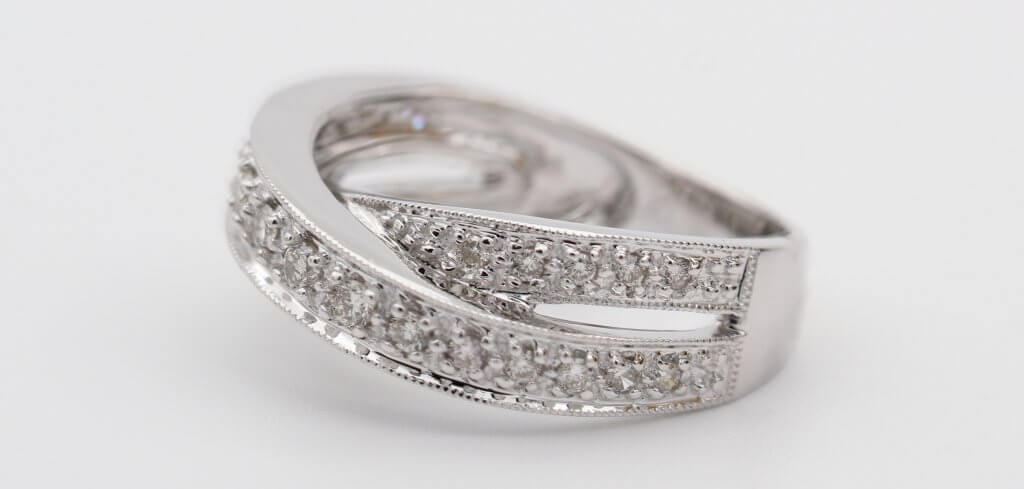The Secret to White Gold Dipping
Key Takeaways
- Most white gold is covered in a thin layer of rhodium, which adds an additional white sheen to the metal, and avoids the warmer, off-white look of un-plated white gold.
- This rhodium will wear off over time, and reveal the gold underneath. It will be relatively subtle but, any time you start to see a hint of warmth shining through, you should take that as a sign that the rhodium is reaching the end of its life.
- Getting the ring re-dipped in rhodium is quick and easy, and inexpensive.
- As with anything related to your bridal jewelry, it’s always best to go back to the original jeweler – someone you know you can trust.

White gold is one of the most popular metal choices for bridal jewelry. While it captures the same stark, bright vibe of platinum, it’s also a lot cheaper, as well as being strong and durable. White diamonds look incredible against it, just as it contrasts beautifully with colored accent stones.
Nevertheless, one of the most commonly touted arguments against white gold, and in favor of platinum, is that it’s higher maintenance. White gold pieces need to be re-dipped every once in a while, in order to them to stay looking as bright and shining as platinum.
Then again, all engagement rings need to be given a regular check-up by the jeweler who created them, so is taking the time to get your white gold re-dipped really a big deal? Here’s everything you’ll need to know.
Does white gold have to be dipped?
Yes. Most white gold is coated in a very thin layer of rhodium in order to achieve that bright, platinum-like color, but that original coating doesn’t last forever – particularly if you’re wearing the item it regularly.
Yellow gold doesn’t need to be dipped, since it doesn’t have a coating to begin with. The same goes for rose gold – while the color has been changed, that pink hue is the result of a combination of gold with copper (and other alloys like silver). It is not achieved using a surface coating.
White gold doesn’t have to be plated in rhodium, but most people prefer it. It’s created using alloys like nickel and zinc and, before being dipped in rhodium, will appear a very, very pale yellow color. It’ll be close to the color you typically associate with white gold, but still feature a discernible hint of warmth.
This is the color you’ll start to see when the rhodium plate starts to wear off your ring – a very subtle hint of gold’s warm, yellow color. It won’t be obvious, and it’s not a big deal, and you’ll probably be the only person to notice it.
How long does white gold plating last?
In general, it lasts between 1 and 3 years.
As you can imagine, gold plating will last longer on some pieces of jewelry than it will on others. A pair of white gold earrings worn once in a blue moon will stay looking bright for a lot longer than a wedding band. Not only is a ring subjected to a lot more wear and tear, but a wedding band is worn day-in-day-out from the moment it is first purchased, and this will cause the platin to wear off much faster.
You don’t need to panic if your white gold plating starts to show signs of wearing off within the first 12 months of purchasing it. It’s simply a sign that the piece has been worn and enjoyed, and that it’s ready for a routine tune-up.
On a ring, the first place you’re likely to notice the plating wearing-off is the inside of the band. Since it’s constantly rubbing against your finger, it’s a lot quicker to wear away there than on the ring’s head, which tends to be left alone most of the time.
Since the less-conspicuous parts of the ring will wear off first, you may not need to go to the jewelers the instant you start to see signs of wear and tear.
But is it okay to wear white gold every day?
Absolutely. If your white gold ring is plated, then it is inevitable that it will wear off and need replacing eventually. That doesn’t mean you can’t wear and enjoy it.
Some metals, like silver, just aren’t strong enough to be worn every day. Regular wear will cause them to get scratched, marked and bent out of shape and, eventually, look very worse for the wear.
White gold is strong. It’s usually sold as 10K or 14K, which means it’s more than capable of withstanding life on your finger. There’s nothing wrong with wearing it every day – although you’ll want to avoid wearing it to swim, workout, sleep, or rock climb, but that’s the same for any precious metal, particularly when there are diamonds involved.
In other words, don’t get anxious about the plating wearing off. It’s going to wear off, and it’s easy enough to replace it.
How much does it cost to get a ring dipped in white gold?
It totally depends on the jeweler and your state, but it generally costs between $50 and $150.
Re-dipping a white gold ring in rhodium is a relatively quick process, but it’s not a five-minute job. Your jeweler will need to polish off what’s left of the previous plating, clean the ring, then dip it in the plating and leave it to dry before giving it a final check.
For us, it’s more than worth the price. While working on the plating, your jeweler can take a look at your ring’s prongs, and any delicate features like a pavé setting on the shank, in order to make sure everything is safe and secure. We recommend a trip to the jewelry store every 6-12 months anyway, so in terms of ‘maintenance’ it’s really no big deal.
Some people do like to invest in a temporary engagement ring for those times when the real ring is with the jeweler, but you won’t be parted from it for long.
Our Summary
White gold is a great choice for an engagement ring. It looks great, lasts for decades, and offers a safe support for your diamond.
It’s true that it’s higher maintenance than platinum, but we’ve never considered this to be a particularly big deal. Getting a ring replated isn’t a major undertaking, and it gives you a chance to check-in with your jeweler.
If you’re starting to see the tell-tale signs of rhodium plating wearing away, then don’t panic – and done assume it’s a permanent sign of damage, or a sign of a cheap ring. It’s normal, expected, and something plenty of people notice every day of the year.

Nov 12, 2021 By Willyou.net
24K Gold: A Guide to Quality

Nov 14, 2021 By Willyou.net
Platinum: Is it Right for You?








